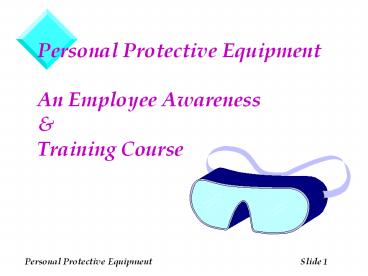Personal Protective Equipment An Employee Awareness & Training Course - PowerPoint PPT Presentation
1 / 16
Title:
Personal Protective Equipment An Employee Awareness & Training Course
Description:
An Employee Awareness & Training Course Federal OSHA Standard Overview Applies to general industry Governs the use, selection, maintenance, fit and disposal of ... – PowerPoint PPT presentation
Number of Views:367
Avg rating:3.0/5.0
Title: Personal Protective Equipment An Employee Awareness & Training Course
1
Personal Protective EquipmentAn Employee
AwarenessTraining Course
2
Federal OSHA StandardOverview
- Applies to general industry
- Governs the use, selection, maintenance, fit and
disposal of Personal Protective Equipment - Employers are to assess hazards in
theirworkplace and select appropriate PPE
3
OSHA StandardGeneral Requirements
- Employers to select PPE based on hazards present
or likely to be present - Prohibits use of defective / damaged equipment
- Requires training employees in PPE use, fit,
maintenance, life expectancy disposal
4
Hazard Assessment
- Employers required to conduct a workplace hazard
assessment - Employees exposed to identified hazards are to be
provided with appropriate PPE - Employers are to certify in writing that the
hazard assessment has been completed - Damaged or defective PPE is not to be used
5
Training
- Employees to be instructed when PPE is necessary,
what type, how to wear it, limitations, proper
care, maintenance, useful life, and disposal - Employers are to certify that training has been
completed and that employees understand it
6
OSHA StandardGeneral Requirements
- TYPES OF PPE
- Clothing, equipment, respiratory devices,
protective shields and barriers - Protect eyes, face, head, torso and extremities
- Process hazards, environment, chemicals,
radiological, or mechanical hazards - Capable of causing injury or impairment through
absorption, inhalation, or physical contact
7
Types of PPE
- Eye Face Protection
- Hearing Protection
- Respiratory Protection
- Head Protection
- Arm Hand Protection
- Foot Leg Protection
- Torso Protection
8
Eye Face Protection
- Protect from flying particles, molten metal,
liquid chemicals, acids, caustic liquids,
chemical gases or vapors, and light radiation - Sideshield protection needed for flying particles
- Use safety prescription lenses or eye protection
worn over regular glasses or contacts - Protection needed to cover multiple hazards
9
Hearing Protection
- Required in high noise areas, depending on the
duration of worker exposure - Long term exposure can result in permanent
hearing loss or impairment - Improperly worn or maintained PPE will not
sufficiently reduce the noise levels - PPE - earplugs or earmuffs
10
Respiratory Protection
- Two Basic Types- Air Purifying Respirators-
Atmosphere Supplying Respirators
11
Head Protection
- Overhead hazards
- Exposed electrical conductors
- Helmets rated as Types 1 or 2 and providing Class
A, B or C protectionA General impact, 2200
volts protectionB 20,000 volts protectionC
Bump protection, no electrical protection
12
Arm Hand Protection
- Hazards from chemicals and other substances,
temperature extremes, sharp objects - Injuries include cuts, abrasions, burns,
amputations, shock, chemical absorption - Glove protection information to be obtained from
the manufacturer - Protection includes gloves, sleeves, hand pads,
wristlets, etc. - Rubber insulating equipment needed for electrical
workers
13
Foot Leg Protection
- Hazards from falling or rolling objects, objects
piercing the sole, electrical hazards, molten
metal, hot surfaces, slippery surfaces - Shoes / boots may provide impact protection,
compression protection, puncture protection - Leggings protect the lower legs and feet from
molten metal and welding sparks
14
Torso Protection
- Hazards include heat, splashes from liquids,
impacts, cuts, and radiation - Injuries include heat burns, radiation burns, and
chemical burns, lacerations, and abrasions - Equipment includes vests, jackets,
apronscoveralls, and full body suits.
15
Care, Use, Maintenance, Disposal of PPE
- PPE is available in various types and styles
- Make sure that the PPE assigned to you fits
properly and snugly - Clean PPE regularly, following manufacturers
suggestions - Be familiar with the life expectancy of your PPE
and dispose of when needed - Report any discomfort, problems or questions to
your supervisor or safety manager
16
Personal Protective Equipment
- Final Discussion
- Question and Answer Period































